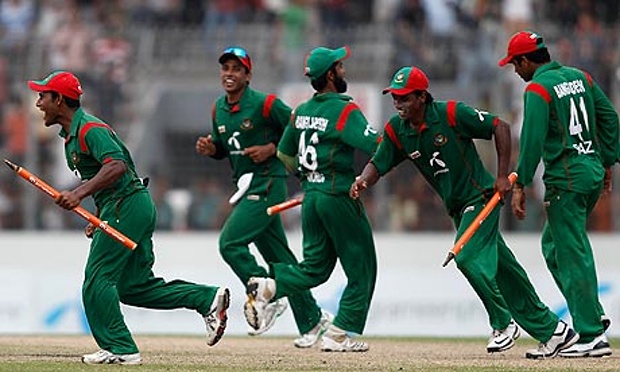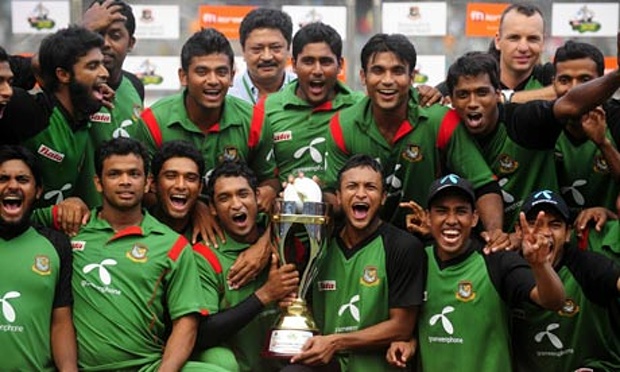All posts by Umama
BAN vs NZ ODI Series 2015
Mustafizur’s 5/50 on debut against India

Bangladesh’s left-arm fast-bowler Mustafizur Rahman picked up five wickets on his ODI debut against India during the first game of the 3-match series at Mirpur today.
Mustafizur grabbed five wickets for 50 runs in 9.2 overs.
The best bowling on debut for Bangladesh belongs to Taskin Ahmed who picked up 5 for 28 in 2014.
Bowling over the wicket with the awkward angle across the stumps, Mustafizur outsmarted opposing batters with brilliant off-cutters time and time again.
Rohit Sharma was the first victim of Mustafizur as the Indian batsman was fooled by a slower off-cutter and was caught at mid-off for 63.
Ajinkya Rahane went for his shot too early to a slower ball and ended up being caught by Nasir Hossain at cover. Rahane scored nine runs.
Mustafizur was on fire in his seventh over when he sent back Suresh Raina and Ravichandran Ashwin in two consecutive deliveries.
Raina was bowled neck and croft for 40 while Ashwin was caught behind for a duck.
Mustafizur completed his fantastic five-for when Ravindra Jadeja was undone by a slower off-cutter and holed out to long-on for 32.
The left-armer could’ve picked up his sixth victim of the match had he held on to a caught-bowled chance of Mohit Sharma.
That wicket would’ve given Mustafizur the best bowling performance for Bangladesh in ODI debut.
Content taken from www.espncricinfo.com
The year of unprecedented home domination in ODIs

The last eight months have been particularly memorable for teams in one-day internationals. Since the World Cup, Bangladesh and England have both made good use of home conditions to overcome opponents far more fancied than themselves: after an impressive World Cup campaign, Bangladesh thrashed Pakistan 3-0 and India 2-1, while England overcame New Zealand 3-2. Two out of four World Cup semi-finalists played away series, and lost against opponents they were expected to beat.
Home advantage has always counted for a bit in cricket, but never as much as it has in one-day internationals in the last eight months. The numbers are quite incredible: in 75 matches, home teams have won 61 and lost only ten, a win-loss ratio of 6.1.
This period began with India’s 5-0 whitewash of Sri Lanka in November last year, and then continued with Australia’s 4-1 defeat of South Africa, and Bangladesh’s 5-0 drubbing of Zimbabwe. In the lead-up to the World Cup, Australia won four games without losing any in the tri-series against India and England, while South Africa beat West Indies 4-1. In the World Cup itself, the two dominant teams were the ones which hosted the tournament: New Zealand won eight out of eight at home, while Australia, the eventual champions, won seven out of seven. (One match, against Bangladesh, was washed out, while their only defeat was in New Zealand.) Since the World Cup, Bangladesh and England have kept the flag flying for the home teams, while Pakistan have chipped in too, with a 2-0 win in a historic home series against Zimbabwe. During these eight months, Australia have a 15-1 win-loss record at home, Bangladesh 10-1, and New Zealand 14-2.
All those results add up to complete home dominance over the last eight months. The table below looks at year-wise ODI home results over the last decade, and never has the skew been as prominent as it is now. In fact, between January and October 2014, home teams won fewer ODIs than they lost. In all the other years since 2005, the win-loss ratio for home teams has never exceeded 1.68 (69-41) in 2010.
In 2015 so far, the ODI win-loss ratio for home teams is 6.5 (39 wins, six losses), which is by far the best in any calendar year. The next-best, with a 20-match cut-off, is 1989 ratio of 2.75 (32-22). When grouping the numbers by decade, though, the 2010s is only marginally ahead of the 1990s, suggesting this is just a one-off occurrence. For the moment, the home teams are surely not complaining.
Content taken from www.espncricinfo.com
BAN vs. SA: Bangladesh hush their ODI critics

Can they make their most successful year in international cricket even better?
By beating South Africa 2-1 in the ODI series last week, Bangladesh propelled to a different stratum of performance and answered the question asked of them at the end of their 2-1 ODI series win over India. Between 2002 and 2011, Bangladesh dreaded playing against South Africa, losing 13 out of the 14 ODIs they played in this period. But in the space of five days, not only did they fight back from three demoralising losses in the T20s and first ODI, they dominated a dominant force.
As their international schedule stands now, Bangladesh have no more ODIs in 2015, and will play in the format again only during a five-match series against Zimbabwe early next year. The BCB is trying to persuade West Indies to play three ODIs and three T20s in November this year, but negotiations are still ongoing.
If the South Africa ODI series was indeed their last of 2015, then Bangladesh should be proud for recording the fourth-most ODI wins in the first six-and-a-half months of the year, and also for ending with the third-best win/loss ratio behind Australia and New Zealand. The 2-1 series win against South Africa also cemented their place in the 2017 Champions Trophy.
The manner in which Bangladesh engineered the turnaround against South Africa was quite simple, but someone had to sit down and do the straight-talking with a team that lost three games in the space of a week.
Mashrafe Mortaza had less than 48 hours to turn around from being 1-0 down on July 10. Coupled with the 2-0 T20 series defeat, there was suddenly some ill-feeling, much of which was unnecessary. Mashrafe held lengthy discussions with the batsmen and bowlers and asked them to remember how they won against India and Pakistan, and repeat it on July 12 and 15.
Content taken from www.espncricinfo.com







